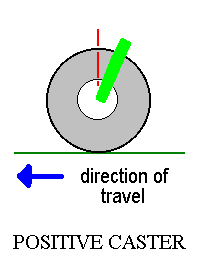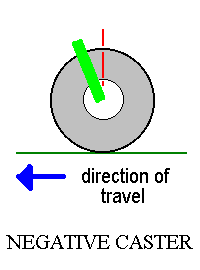Caster
Caster is a measurement of tilt in the steering knuckle of the car as viewed from the side. Specifically, it is the angle of tilt (in degrees) from the vertical of an imaginary line drawn through the upper and lower ball joints. If the wheel has positive caster, the steering axis leans backward (like on a bicycle); if the wheel has negative caster, the steering axis leans forward (like on a roller chair). Caster is important for directional control, feedback through the steering wheel, and natural return to straight-ahead after completing a turn.


Positive caster wheels resist turning because they lift the vehicle front end slightly as they are turned. They have a beneficial tendency to return to a straight-ahead position. Most vehicles with power steering have their front wheels set with positive caster. Conversely, most vehicles without power steering have their front wheels set with negative caster to reduce steering effort. Negative caster wheels are easy to turn, but they swivel and follow road irregularities.